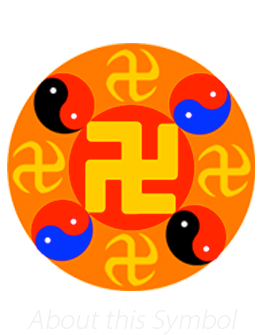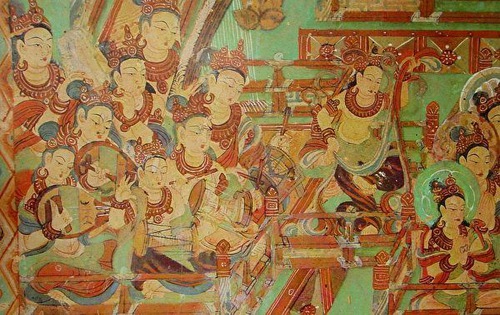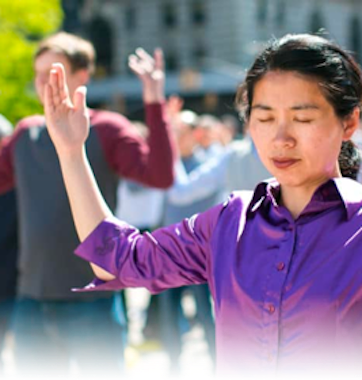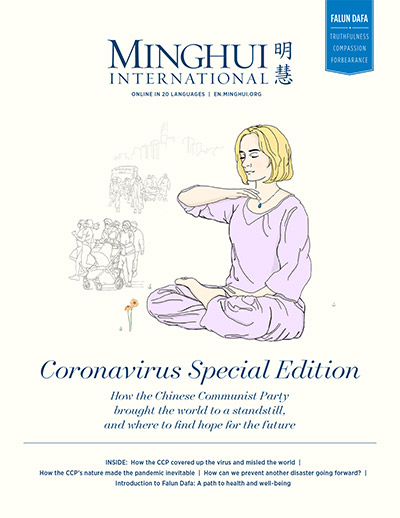(Minghui.org) Cultural heritage encompasses the wisdom of our ancestors, and shows us how human society has developed. It provides a rich resource for future generations to understand our history, with all its profound wisdom. Protecting cultural heritage is therefore very important, so that we can pass down and preserve traditional culture.
Hard battles have been fought for the preservation of cultural relics. Some of these are described below.
Rescuing National Treasures from the Louvre
In 1940, Hitler ordered the capture of Paris. Millions of Parisians fled and Paris was suddenly empty. The curator of the Louvre, Jacques Jaujard, was determined to save as many cultural treasures as he could. He packed 1,862 boxes of precious cultural relics, including the “Three Treasures of the Louvre,” (the Mona Lisa, The Winged Goddess of Victory, and Venus de Milo), as well as 4,000 boxes of artifacts. A total of 203 trucks were used to transfer the treasures overnight to various castles to be hidden.
On the day the last collection left the Louvre, Paris was captured by the Nazis, and Hitler’s plan to “take the Louvre” failed. This thrilling episode in history was later made into the movie “Francofonia.”
Chiang Kai-shek Rescued Chinese National Treasures from Destruction
In January 1933, the Japanese army broke through Shanhai Pass (also known as Shanhaiguan, one of the major passes in the Great Wall of China). Chiang Kai-shek, director general of the National Party of China who fought the Japanese invaders and later the Chinese Communist Party during the Chinese civil war, was a strong protector of national cultural heritage. He ordered his men to transfer thousands of cultural relics to a safe place during the Japanese bombing.
On February 5, 1933, during a dark and stormy night, martial law was suddenly imposed in the Forbidden City. A convoy of thousands of sealed wooden boxes was then quietly escorted out of the city through Shenwumen (The Gate of Divine Prowess). The escorts were dressed completely in black and the convoy was guarded by soldiers and armed police. So began the nation’s largest and most successful transfer of cultural relics, with profound historical consequences for Chinese history.
Later, two trains loaded with 19,557 boxes of national treasures bypassed Tianjin, then traveled on the Pinghan Line, the Longhai Line, and the Jinpu Line, before arriving in Shanghai. This mission relocated priceless national treasures, including the complete set of “Siku Quanshu” (Complete Collection in Four Treasuries)—a vast collection of Chinese scholarship from antiquity to the 18th century—the original calligraphy “Quick Snow and Sunny Post” by esteemed Wang Xizhi in the Jin dynasty, an emerald jade cabbage, and other ancient calligraphic works, paintings, and precious objects.
The National Party of China had invested heavily in military supplies for the war against the Japanese invasion, so finance and transportation were scarce. Even so, Chiang Kai-shek personally approved the allocation of wagons to transport the national treasures to various places in Sichuan and Guizhou in Southwest China.
During some parts of the journey, the treasures had to be moved onto trucks when passing through the Sichuan-Shaanxi Highway, and each truck could only carry about 20 boxes. The journey was particularly difficult due to damaged roads and broken bridges.
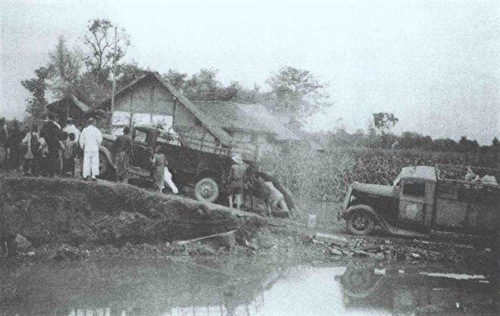 The arduous journey to relocate cultural relics to West China
The arduous journey to relocate cultural relics to West China
After the Anti-Japanese War ended, civil war broke out between the Soviet-backed Chinese Communist Party (CCP) and the Nationalist government led by Chiang Kai-shek.
In 1948, as Chiang Kai-shek was planning to retreat to Taiwan, he did two judicious things relating to China’s cultural heritage. The first was to fly the masters of Chinese studies to Taiwan. The second was to relocate national treasures from China to Taiwan.
The national treasures in mainland China were relocated five times between December 21, 1948 and December 9, 1949—the first three by boat and the last two by air. Chiang Kai-shek had ordered that the treasures to be relocated as fast as possible, no matter the cost. Eventually, after untold hardships, 680,000 pieces of national treasure were relocated from mainland China to the National Palace Museum in Taipei.
On December 9, 1949, Zhang Daqian, a grand master of traditional Chinese painting, sped to Xinjin Airport in Chengdu in a high-ranking official’s car. He had with him 78 reproductions of Dunhuang murals from his private collection. However, the plane was already overloaded and couldn’t allow the additional weight of the artworks.
In desperation, Hang Liwu, the deputy education minister of the National government, voluntarily discarded his three pieces of luggage, which included his life savings of some twenty odd taels of gold, in order to make space for the murals on the plane. He did this on condition that Zhang Daqian would donate the murals to the country after he got to Taiwan. Zhang Daqian agreed and kept his promise.
Although cultural relics can be fragile and vulnerable, none of the treasures taken from the Forbidden City were broken or damaged after their long and perilous journey. It was as if they had been protected by the gods.
Na Zhiliang, one of the first group of staff from the Forbidden City who helped escort the national treasures, recalled: “It was only after I witnessed how we could always leave safely just at the moment of enemy bombing, and survive without any damage—even when our truck was overturned and the boat capsized—that I began to believe that all those ancient objects have spirits and intelligence.” Later, he wrote the book Guarding the National Treasures of the Forbidden City for Seventy Years.
From 1961 to 1962, some of the national treasures relocated to Taiwan by Chiang Kai-shek were exhibited in five cities in the U.S., including Washington DC, to 470,000 visitors.
Chiang Kai-shek deserved much credit for his great contribution in keeping the cultural relics intact, in spite of the catastrophic effects of war. However, the treasures left behind in China, including works by national masters and cultural relics, suffered devastating destruction during the Cultural Revolution (1966-1976) at the hands of Mao’s Red Guards.
The CCP Destroyed Countless National Treasures
While the national treasures rescued by Chiang Kai-shek were being exhibited to people in the U.S., the CCP regime in mainland China was brewing a devastating destruction of China’s traditional culture.
The People’s Daily published an editorial titled “Sweep Away All Monsters and Demons,” on June 1, 1966, effectively declaring that all enemies of the CCP were subhuman. The article advocated the slogan of “abolishing the four olds” (old ideas, old culture, old customs, and old habits), which was one of the major goals of the Cultural Revolution.
On August 18, Mao received representatives of the Red Guards in Tiananmen. The Red Guards in Beijing then started smashing up the “four olds,” resulting in an immediate and devastating destruction of Buddhist and Taoist temples, Buddha statues, historical sites, traditional calligraphic works, paintings, and antiques.
 The CCP’s unprecedented “destruction of the four olds” aimed to destroy traditional Chinese culture.
The CCP’s unprecedented “destruction of the four olds” aimed to destroy traditional Chinese culture.
It’s estimated that over 10 million homes across China were searched and ransacked. Countless treasures, calligraphy and paintings, books, utensils, ornaments, and ancient books were smashed to smithereens or burned to ashes.
Of the 6,843 cultural relics and historic sites listed in Beijing’s 1958 cultural relics survey, 4,922 were completely destroyed during August and September 1966.
In addition, the tomb of Confucius in Shandong Province was excavated and his remains were scattered. More than 5,300 pieces of ancient books, calligraphy and paintings, national first-grade cultural relics, and stone monuments related to Confucius were also destroyed.
Even the ancient buildings that carried the memories of ancient times weren’t spared. In Beijing, the inner and outer city walls were demolished, leaving only four gates—Tiananmen, Zhengyangmen, Deshengmen, and Yongdingmen. These walls and buildings had survived multiple civil wars and social upheavals since the Liao Dynasty nearly 1,000 years ago, only to be destroyed by the brutality of the CCP.
The CCP’s Cultural Revolution severed the roots of China’s traditional culture, resulting in a major degeneration of national civilization, which continues to today.
A year after the Cultural Revolution started, Chiang Kai-shek gave a speech at the “Commemoration Ceremony of the Founding Father’s Birthday and Cultural Revival Day” on November 12, 1967. He said, “The evil demonic nature of CCP bandits is in total contradiction to our three principles for the people (nationalism, democracy, people’s livelihood) based on China’s traditional culture and values! The CCP tries to eliminate China’s 5000-year long traditional culture deeply rooted in our hearts by desperately destroying our cultural ethics, democracy, and science, which is based on traditional culture. The so-called ‘Cultural Revolution’ is no more than a superficial ‘cover up’ for its destructive crimes against traditional culture. Today’s mainland has become a huge prison where normal relationships between father and son, husband and wife … are regarded as treasonous and are constantly criticized.”
Chiang Kai-shek believed that communism, as the biggest public enemy of mankind, would eventually perish. In 1972, he accurately predicted that the communist countries in Europe would disintegrate in 1990, while the CCP would follow suit a bit later. And he believed that what could really save China and defeat the demons of communism was the Chinese culture that has been rooted in the hearts of Chinese people for generations.
In his speech, Chiang Kai-shek said, “No one can destroy Chinese culture! What will eventually eliminate the communist bandits and thieves lies in the righteousness of the ‘national independent character and ability’ manifested in our Chinese culture!”
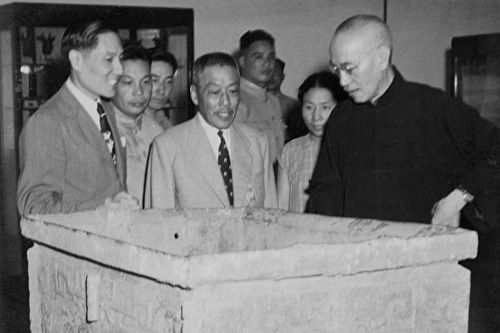 Chiang Kai-shek, his wife Soong Mei-ling and their son Chiang Ching-kuo visiting a national treasure exhibition in Nanjing in 1947.
Chiang Kai-shek, his wife Soong Mei-ling and their son Chiang Ching-kuo visiting a national treasure exhibition in Nanjing in 1947.
Protection Versus Destruction
There is a saying that the Forbidden City in Beijing “has palaces but no treasures,” while the Forbidden City in Taipei “has treasures but no palaces.” The meaning is that even though the “Forbidden City” in both places showcases China’s ancient and splendid culture, the CCP and the National Party of China have completely different attitudes towards culture and cultural relics.
The National Palace Museum in Taipei takes good care of Chinese cultural relics, and has meticulous regulations on how to handle them. If any article is to be moved, two or three people must be present, and the whole process is monitored and recorded on video.
However, relics in the Forbidden City in Beijing are treated with negligence, resulting in damage. Damaged relics include the red sandalwood screen in the collection of the Qing dynasty, first-grade Ming dynasty ritual utensils, and a first-grade Song dynasty kiln green glazed sunflower mouth plate. Unbelievably, the Palace Department even threw out more than a dozen precious Buddha figures, left inside a box of rubbish. People handling the waste boxes found the Buddha figures and later returned them to the Palace Museum.
It’s said that between 2000 and 2007, the Palace Museum in Beijing permanently lost more than 100 rare ancient books, including engraved editions from the Ming dynasty.
Why Does the CCP Want to Destroy Traditional Culture?
China used to be known as “Shenzhou” (Divine Land), and China's traditional culture was regarded as a divinely inspired culture bestowed by gods. Traditional Chinese characters, believed to be invented by divine beings, also had a close tie with ancient Chinese moral values and perceptions.
Calligraphy sage Wang Xizhi of the Eastern Jin Dynasty (303-361 AD) is said to have spent several years practicing the character “永” (meaning eternal). This character contains all eight basic strokes in Kai style calligraphy. It is said that a Taoist at Tiantai Mountain showed him how to write it. By practicing writing this character, Wang mastered the most important skills of Chinese calligraphy. The Taoist also told him that he should always keep a pure and noble mind while practicing calligraphy. After years of persistent effort, Wang became one of the greatest calligraphy masters in Chinese history.
As the story goes, Wang used to practice writing near a pond, and when he finished, he would wash his brush and ink-stone in the pond. Over time, the water in the entire pond turned black, and it was known as the “ink pond.”
Ancient calligraphy and painting required attention to “both form and spirit.” Artists emphasized the importance of cultivation practice and believed in “harmony between man and nature.” It is precisely due to such realms of enlightenment that their works turned out to be so vivid, with timeless significance. These works reminded later generations of the connection between man and the divine, so that they would not forget where they had come from or get lost in the maze of the secular world.
Yet the CCP spares no effort to destroy cultural heritage and the essence of China’s traditional culture. The fundamental reason is that the CCP’s promotion of Marxism and atheism are the complete opposite of traditional Chinese culture and values.
The CCP has used all kinds of evil tricks throughout its repeated political movements, including brutal massacres, destruction of religious beliefs, persecution of intellectuals who uphold justice and conscience, and the destruction of traditional Chinese culture—including ancient temples, cultural relics, calligraphic works, paintings, and antiques. The CCP’s ultimate goal is to dominate the entire world and sever the connection between man and the divine, pushing humanity into a dangerous abyss.
It is immensely important for people to be fully aware of the evil nature of the CCP. This will allow them to break away from its influence and enlighten to the importance of reviving and following the traditional cultural values of virtue, righteousness, propriety, benevolence, and trustworthiness. All this will ensure a bright future for humanity.
Copyright © 2023 Minghui.org. All rights reserved.
Category: Traditional Culture
